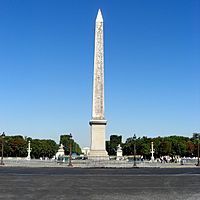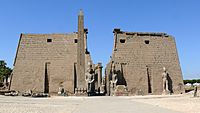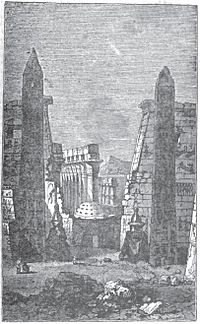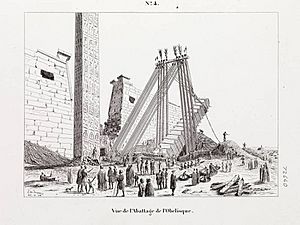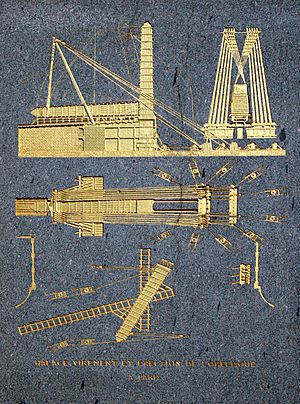Luxor Obelisks facts for kids
The Luxor Obelisks are two tall, ancient Egyptian stone pillars. They are over 3,000 years old! These huge stones were carved to stand at the entrance of the Luxor Temple in Egypt. This happened during the time of a powerful pharaoh named Ramesses II, around 1250 BC.
One of these obelisks, the one on the right, is about 23 meters (75 feet) tall. It was moved in the 1830s to a famous square in Paris, France, called the Place de la Concorde. The other obelisk, the one on the left, is still in its original spot in Egypt. The Luxor Obelisk in Paris was officially recognized as an important historical monument in 1936.
Contents
The Obelisks in Ancient Egypt
How They Were Made
The Luxor Temple was built about 150 years before Ramesses II became pharaoh. During his rule, he made many changes to the temple. This included adding the two grand obelisks.
Each obelisk was carved from a single, giant piece of red granite. This stone came from a quarry about 160 kilometers (100 miles) south of Luxor, in a place called Aswan. To move these massive stones, workers used a special barge (a flat boat). They then used ropes and sand to carefully lower them into their final positions.
What They Looked Like
The two obelisks were not exactly the same height. The one that stayed in Luxor is a bit taller. The shorter obelisk was placed on a taller base. It was also set a little farther away from the temple entrance than the other. This clever design made both obelisks look like they were the same height to someone walking towards the temple.
The obelisk still in Luxor leans a bit today. The one in Paris has a small crack in its stone. This crack was repaired a very long time ago. The front and back sides of both obelisks were slightly curved. This is very unusual for ancient obelisks, and experts are not sure why they were made this way.
Secret Messages: Hieroglyphs
Both obelisks are covered with hieroglyphics. These are ancient Egyptian picture writings. In the 1800s, a scholar named François Chabas translated the writings on the Paris obelisk. The hieroglyphs tell stories about Ramesses II and the gods Amun-Ra and Horus.
The Obelisk's Journey to Paris
The Idea to Move One
The idea of bringing the Luxor Obelisks to Paris first came up during Napoleon's time. In 1799, one of his generals, Louis-Charles-Antoine Desaix, wrote to Napoleon. He said that two obelisks in Thebes (ancient Luxor) would look amazing in Paris. Another person, Vivant Denon, also wrote about moving the obelisks as a sign of French victory. However, these plans did not happen at that time.
Later, under King Louis XVIII, France gained rights to another obelisk in Alexandria. But this one was never moved to France. It ended up in New York City in 1881.
In the 1820s, King Charles X wanted an obelisk for a new Egyptian Museum. Around this time, Jean-François Champollion became famous for understanding Egyptian hieroglyphs. He saw the Luxor obelisks and strongly suggested that France get them.
A Special Gift from Egypt
In November 1830, Muhammad Ali Pasha, who ruled Egypt, officially gave the Luxor obelisks to France. He had first offered them to the British. But a French official, inspired by Champollion, convinced him to change his mind. Instead, the British received a different obelisk from Karnak Temple. Champollion knew this one would be very hard to move.
In return for the obelisk, France gave Egypt a special mechanical clock in the 1840s. This clock is now known as the Cairo Citadel Clock. It has rarely worked since it arrived in Egypt. However, in 2021, Egypt announced plans to fix it.
In 1981, the French President François Mitterrand officially gave up France's claim to the second obelisk. This meant it fully belonged to Egypt again.
Moving the Giant Stone
It was decided that the western (shorter) obelisk would be moved first. In 1831, it was carefully taken down. A special ship called the Luxor was built just to carry it. The obelisk arrived in Paris in 1833. It was then set up in 1836 in the center of Place de la Concorde by King Louis-Phillipe. Sadly, Champollion, who had wanted the obelisk moved, died in 1832 before the project was finished.
Moving the obelisk was very expensive. This high cost might be why the second obelisk was never moved to Paris.
The Place de la Concorde was chosen for the obelisk because it was a very important and emotional spot. It had been a main site during the French Revolution. The obelisk was a perfect fit because it was very old and had no connection to French history. This helped avoid any political arguments.
The Base of the Obelisk
In 1839, drawings showing the complex machines used to move the obelisk were added to its base.
The original Egyptian bases of the obelisks had sculptures of baboons. These baboons were shown raising their hands to the sun. A piece of the original base from the obelisk still in Egypt was brought to Paris. It is now in the Egyptian section of the Louvre Museum.
The Golden Top
In 1998, France added a gold-leafed pyramid cap to the very top of the obelisk. The money for this came from a fashion brand, Yves Saint Laurent. People had long thought that the bare top of the obelisk originally had a cap made of bronze, gold, or a mix of gold and silver. It was believed this cap was stolen around 500 BC.
With its base and new golden cap, the monument is now about 33.37 meters (109 feet) tall.
Fun Facts and Modern Times
- In 1998, Alain Robert, known as "Spiderman," illegally climbed the Parisian obelisk. He did it without any ropes or safety gear!
- Also in 1998, the monument was covered by a replica of the 1998 World Cup trophy.
- In 1999, for Paris's millennium celebration, the obelisk was turned into a working sundial. They placed brass disks and yellow strips around it. These stayed until the end of 2000.
- In 2015, a large interactive sculpture called PHARES was placed next to the obelisk for several months. It was designed to light up the obelisk.
See also
 In Spanish: Obelisco de Luxor para niños
In Spanish: Obelisco de Luxor para niños
- Cleopatra's Needle
- List of Egyptian obelisks


